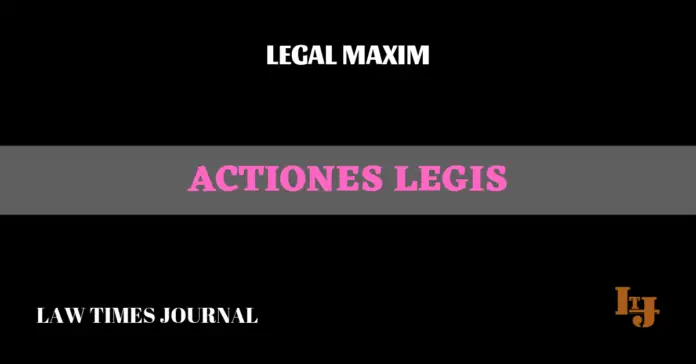
Literal Meaning
Law suits.
Explanation & Origin
The history of Roman Law can be divided into three systems of procedure: that of legis actiones, the formulary system, and cognitio extra ordinem. The periods in which these systems were in use overlapped one another and did not have definitive breaks, but it can be stated that the legis actio system prevailed from the time of the XII Tables (c. 450 BC) until about the end of the 2nd century BC
In the Roman law. Legal or lawful action; actions of or at law
Roman legal procedure, long evolving system used in the Roman courts, which in its later stages formed the basis for modern procedure in civil-law countries. There were three main, overlapping stages of development: the legis actiones, which dates from the 5th-century BCE law code known as the Twelve Tables until the late 2nd century; the formulary system, from the 2nd century BCE until the end of the Classical period (3rd century CE); and the cognitio extraordinaria, in operation during the post-Classical period.
The procedure under the legis actiones was divided into several steps. First, the plaintiff approached the defendant in public and called for him to come to court. If he refused, he could be taken there by force. The trial itself was divided into two parts. The first was a preliminary hearing held before a magistrate who decided whether there was an issue to be contested and, if so, what it was. Each step in this procedure was extremely formal. If the wrong words were used by either party, that party might lose the case. After the issues were delineated and sureties set, both parties agreed upon a judex, who was neither a lawyer nor a magistrate but a prominent layman, to try the case. The proceedings before the judex were more informal: advocates spoke and gave evidence, and witnesses often appeared. The judex made a decision but had no power to execute it. If the defendant refused to pay the fine or make restitution within a certain period of time, he could be brought by force to the magistrate. Then his property could be seized, or he could be made slave to the plaintiff to work off the debt or property claim.
Illustration
When A instituted a suit against B , A was obliged to make his claim according to a certain prescribed form of words , derived directly from the law upon which the claim was founded , and to this form it was necessary to adhere strictly.
Case Reference
Mithlesh Rani vs The State Transport Appellate tribunal [(1994) INSC 161]
In this case it was held that : in legal terminology it has the sense of directions sent by the Magistrate to the Judge for the disposition of cases, with respect to which the legis actions (forms of actions) were inadequate. Word ‘formulate’ thus is to be understood as to express in a formula, or as a formula; or to put or State in exact, concise and systematic form.
Kerala Students Union vs Sojan Francis [2004 (2) KLT 378]
In this case it was decided that : In common parlance, discipline may be a state of order maintained by training and control a particular system of regulation or conduct, instructions and exercise, designed to train to proper conduct or action
Edited by Vigneshwar Ramasubramania
Approved & Published – Sakshi Raje





